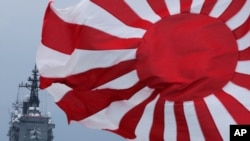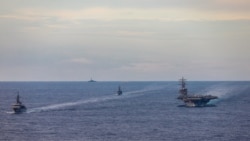Naval forces from the U.S., Australia, Canada, Germany and Japan have concluded a 10-day military drill in the Philippine Sea off the southern coast of Japan, with analysts saying the threat posed by China in the Indo-Pacific region has increased the importance of the military exercises.
The Japan Maritime Self-Defense Force ran the naval exercise as it has since the 1990s. Known as ANNUALEX 2021, the drill ran from November 21 to 30. According to a statement by the U.S. Navy, the five participating nations engaged in events to “enhance maritime communication skills, anti-submarine warfare operations, air warfare operations, replenishments-at-sea, cross-deck flight operations and maritime interdiction maneuvers.”
A month earlier, aircraft carriers from the U.S. as well as a Japanese ship that accommodates helicopter landings participated in an exercise in the same region, according to the Wall Street Journal.
Grant Newsham, a retired U.S. Marine colonel and a senior researcher at the Japan Forum for Strategic Studies, told VOA Mandarin that in recent years, due to the threats posed by China, the military exercise has doubled in realism.
“A total of 34 warships from the five countries conducted a 10-day exercise, demonstrating the importance of this exercise,” Newsham told VOA in a phone interview.
He added that while it is routine for the Japan Maritime Self-Defense Force to conduct exercises, “it’s the broader context in which the exercise is happening that adds a certain urgency” as “China’s People’s Liberation Army is increasingly aggressive and spewing threats throughout the region.”
Wang Tsun-yen, a research fellow at the Institute for National Defense and Security Research in Taiwan, echoed Newsham’s thoughts about China’s stance.
"If we think back to the operations of Chinese and Russian warships around Japan this year, those operations that almost circled Japan's territory are very provocative for Japan, so now countries outside the Indo-Pacific region have come to support Japan,” Wang told VOA Mandarin in a phone interview.
“The expansion of joint military exercises is sufficient to let China and Russia know that Japan is not alone, and it is not only the U.S. military that supports Japan," Wang said.
In September, Japan’s defense ministry said what were believed to be a Chinese submarine and a Chinese destroyer were spotted near Amami Oshima island, according to Reuters.
Earlier this year, China accused the U.S. fleet operating in the South China Sea of increasing regional security risks, “misunderstandings, misjudgments, and accidents at sea.”
Washington does not recognize Beijing’s claim to virtually all of the South China Sea, an area of strategic competition between the two nations.
According to a November 22 report by China’s state-backed news outlet Global Times, China’s Ministry of National Defense spokesperson Tan Kefei said that “individual countries have been vocal in support of freedom and openness, but in fact they have formed gangs to exert pressure on other countries.” He called this a Cold War mentality contrary to promoting cooperation in the region.
Newsham said the choice of the location for the joint exercise is related to a November 18 incident in which Chinese coast guard vessels shot water cannons at two Philippine boats resupplying Philippine troops at a disputed South China Sea shoal, according to the Associated Press.
China claims more than 95% of the South China Sea region.
It has continued to engage in island building campaigns – some 1,300 hectares of tiny islets have been landfilled to sustain military infrastructure including runways long enough to accommodate bombers.
Newsham added the frequency and intensity of military exercises of the Japan Self-Defense Force has grown to reflect China’s increased presence in the area.
“You'll note that Japan is exercising with three countries besides the United States in what is effectively a 'warfighting' exercise. Not so many years ago this would have been politically impossible owing to Japan's self-imposed legal restraints and fears of being seen as engaging in 'collective self-defense' – supposedly prohibited by Japan's constitution,” he said.
“Nowadays, however, a multinational exercise like ANNUALEX provokes no public or political push-back. China has indeed shifted Japanese thinking towards defense,” Newsham added.
Just five days before ANNUALEX 2021 began, Japan and the U.S. conducted their first anti-submarine warfare exercise in the South China Sea, according to the Japanese Navy.
Newsham said that there will likely be more joint military exercises in the region.
“Exercising in the South China Sea with the Americans is at least in part a message to China that the Americans and Japanese won't be intimidated,” he continued, pointing out that not so long ago the Japanese would have avoided exercises with the Americans in the South China Sea for fear of upsetting the Chinese.
“Japan now seems willing to take that risk,” Newsham added.





